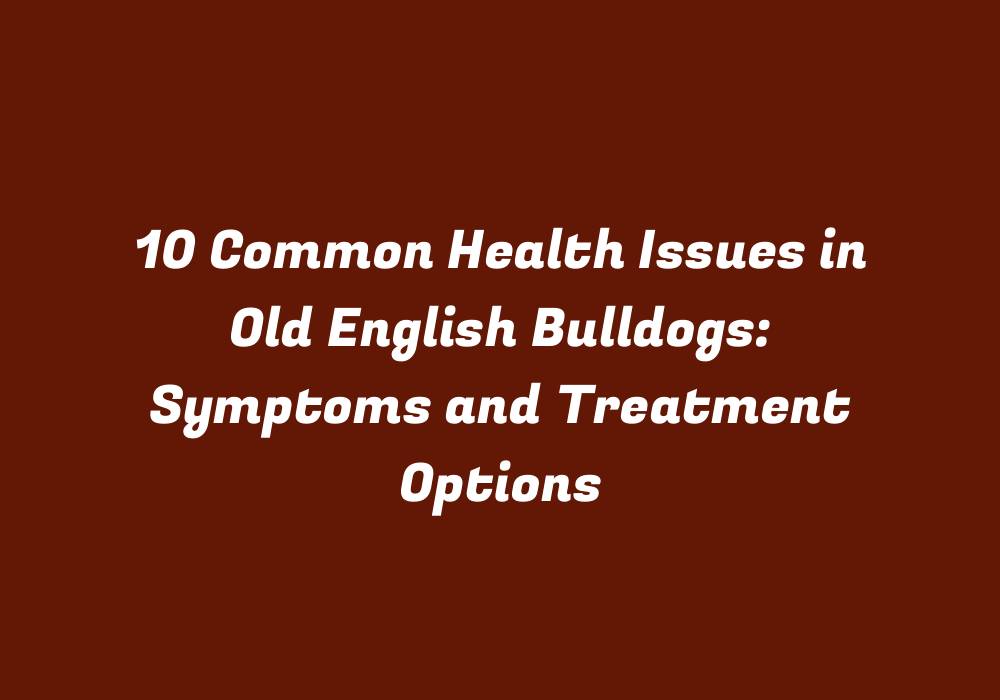10 Common Health Issues in Old English Bulldogs: Symptoms and Treatment Options
Old English Bulldogs are known for their unique and charming appearance, but like any other breed of dog, they face various health issues. Understanding these problems can help owners recognize early warning signs and take the necessary steps to ensure the well-being of their pets. In this article, we’ll discuss 10 common health concerns faced by Old English Bulldogs along with their symptoms and potential treatment options.
1. Brachycephalic Airway Syndrome
Brachycephalic Airway Syndrome is a condition that affects dogs with short muzzles, like the Old English Bulldog, due to their distinctive head structure. This issue can lead to difficulty in breathing and may include enlarged tonsils, an elongated soft palate, or excess tissue in the larynx, trachea, or nose area. Symptoms include heavy panting, excessive effort while breathing, and a gagging sound during exercise. The best solution is to seek veterinary consultation for proper diagnosis and management, as this condition requires specialized care.
2. Hip Dysplasia
Hip dysplasia occurs when the ball-and-socket joint in the hip doesn’t fit together correctly, leading to misalignment and reduced function. It can cause pain, arthritis, and even lameness. Signs of this condition include difficulty getting up after lying down or sitting for extended periods, limping while walking, or showing signs of stiffness and discomfort in the hind legs. Early diagnosis is crucial to prevent further degeneration and alleviate the symptoms through appropriate treatment options, such as physical therapy and possibly surgery for severe cases.
3. Elbow Dysplasia
Similar to hip dysplasia, elbow dysplasia affects the elbow joint’s ball-and-socket structure, leading to pain, swelling, and restricted movement. Symptoms may include limping or reluctance to run, jump, or climb stairs. Diagnosis is confirmed by a thorough physical examination and radiographs. Treatment typically involves medication for pain relief and sometimes surgery for more severe cases to repair the affected area.
4. Skin Problems
Old English Bulldogs are prone to various skin issues due to their unique anatomy, including wrinkles and folds in their face, body, and ears. These areas can trap moisture, leading to bacterial or fungal infections if not properly cleaned and maintained. Common symptoms include itching, redness, swelling, or the presence of discharge. Keeping the dog’s skin clean and dry is essential, along with regular brushing to prevent matting and minimize trapped bacteria. Consult your veterinarian for professional advice on addressing specific concerns.
5. Entropion
Entropion refers to the inward rolling of an eyelid’s edge toward the eye itself, affecting both dogs’ upper and lower lids. This condition can result in corneal irritation, tearing, and potential ulcerations. It is a hereditary issue, so it’s essential to be aware of any family history when choosing a breeder or purchasing a puppy. Surgery is typically the best solution for correcting Entropion and preventing further damage to the eye.
6. Cherry Eye
Cherry eye, or prolapsed nictitating membrane, involves the abnormal exposure of the gland’s third eyelid. It is a common issue in many breeds, including the Old English Bulldog. Symptoms include redness around the affected eye and a noticeable “cherry” protrusion from its edge. While cherry eye may not always require treatment, it can affect vision if left untreated, so consulting with a veterinarian to determine the best course of action is advisable.
7. Brachycephalic Upper Airway Syndrome
Brachycephalic Upper Airway Syndrome (BUAS) is another condition affecting Old English Bulldogs due to their distinctive head structure, causing narrow airways and obstructive breathing issues. Common symptoms include snorting or gagging sounds during respiration, open-mouthed breathing, difficulty exercising, and even fainting episodes. The best approach is early detection by a veterinarian followed by proper care and management to minimize discomfort and improve the dog’s quality of life.
8. Hypothyroidism
Hypothyroidism occurs when the thyroid gland doesn’t produce enough hormones, resulting in various symptoms like weight gain, lethargy, skin conditions, or even reproductive issues. Although it’s not exclusive to Old English Bulldogs, they have a higher risk due to their propensity for other health problems and certain genetic predispositions. Blood tests can help diagnose hypothyroidism, and treatment often includes daily medication to supplement the thyroid hormone.
9. Degenerative Myelopathy
Degenerative Myelopathy is a neurological condition that affects dogs’ spinal cord and leads to progressive weakness in their hind legs, eventually resulting in paralysis. This disease has no cure, but early diagnosis can help manage symptoms through physical therapy, mobility assistance, and appropriate dietary adjustments to minimize the impact on quality of life for affected dogs.
10. Allergies
Old English Bulldogs are also prone to developing allergies due to their sensitive skin and unique breed characteristics. Common symptoms include itching, redness, hair loss, or hotspots caused by biting and scratching. Environmental factors, food ingredients, flea allergens, or even contact with certain substances can trigger allergic reactions. Consult a veterinarian for proper diagnosis and treatment to determine the best course of action, which may include dietary changes, topical treatments, or medication.
In conclusion, understanding the health issues common in Old English Bulldogs is crucial for ensuring their well-being throughout their lives. Early detection and appropriate management can help minimize discomfort and maintain a high quality of life for these loving companions.
